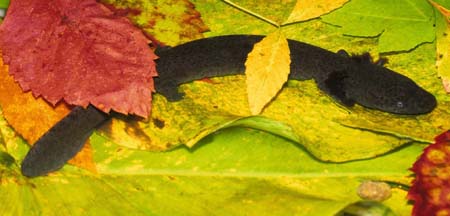
While it’s also referred to as a “mud puppy,” the Black Warrior waterdog is canine in name only. Rather, it’s a current candidate for the federal endangered species list that calls various forks of the upper Black Warrior River drainage home.
Spread out over Blount, Tuscaloosa, Walker and Winston counties in central Alabama, the Black Warrior waterdog (necturus alabamensis) is a type of salamander whose gills allow it to thrive in aquatic habitats. They’re large – with a largest recorded length of 9.8 inches – and have a variety of colorations, some of which include spots, as adults. After passing the hatchling stage, young Black Warrior riverdogs have four distinct stripes from the nostril to the tail: two dark brown stripes separated by cream and yellow stripes.
Black Warrior waterdogs are night owls, navigating the rocky, leafy and moderate-to-large-sized streams that they call home. They live in streams that have moderate flows and feed on small fish, fish eggs, insect larvae, and crayfish, among others.
However, while the Black Warrior waterdog doesn’t have any specific predators, their population is still at risk. Due to their limited geographic distribution, populations at specific locations are low, and increased pollution and sedimentation in their watery habitats run the risk of lowering the water quality.
As a candidate for the federal endangered species list, the Black Warrior waterdog is one of the many species that our efforts at the Freshwater Land Trust aim to help. By protecting and preserving the waters and lands where species like the Black Warrior waterdog live, we help to ensure that the biologically diverse population of Alabama can thrive for years to come.
